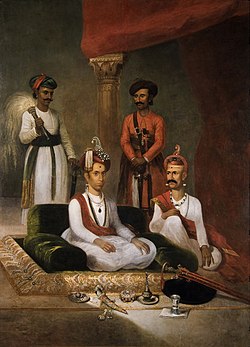Madhavrao II
This article needs additional citations for verification. (February 2013) |
Madhav Rao II | |
|---|---|
 Madhav Rao Narayan | |
| In office 1774 – 27 October 1795 | |
| Monarch | Rajaram II of Satara |
| Preceded by | Raghunathrao |
| Succeeded by | Baji Rao II |
| Personal details | |
| Born | 18 April 1774 |
| Died | 27 October 1795 (aged 21), Shaniwar Wada, Pune, Maratha Empire. |
| Relations | Vishwasrao(Uncle) Madhavrao I(Uncle) Nanasaheb Peshwa(Grandfather) Gopikabai(Grandmother) |
| Parent(s) | Narayanrao Peshwa(Father) Gangabai Sathe(Mother) |
| Residence | Shaniwarwada, Pune, Maratha Empire |
| Profession | Peshwa |
Madhav Rao Bhat II (18 April 1774 – 27 October 1795) was the 12th Peshwa of the Maratha Empire in India, from his infancy. He was known as Sawai Madhav Rao or Madhav Rao Narayan. He was the posthumous son of Narayanrao Peshwa, murdered in 1773 on the orders of Raghunathrao. Madhavrao II was considered the legal heir, and was installed as Peshwa by the Treaty of Salbai[1] in 1782 after First Anglo-Maratha War.
Early life[edit | edit source]
Madhavrao II was the posthumous son of Peshwa Narayanrao by his wife, Gangabai. After Narayanrao's murder by Raghunathrao's supporters, he became the Peshwa. But he was soon deposed by Nana Phadnavis and 11 other administrators in what is called "The Baarbhaai Conspiracy" (Conspiracy by the Twelve). Raghunathrao was tried, convicted, and sentenced to death by the justice Ram Shastri Prabhune but the sentence was never carried out. They instead installed Gangabai's newborn son, Madhavrao II, as the Peshwa. The twelve then formed a council of the state known as the Bara Bhai for the conduct of the affairs of the state in the name of the new Peshwa, Sawai Madhav Rao, as he was made Peshwa when he was barely 40 days old. His time in power was dominated by the political intrigues of Nana Fadnavis.
Reign[edit | edit source]

First Anglo-Maratha War[edit | edit source]
After the British loss in 1782 in the First Anglo-Maratha War, Mahadji Shinde got Madhvrao recognized as Peshwa by the British. However, all powers of the Peshwa were in the hands of ministers like Nana Fadnavis, Mahadaji Shinde and others.
Involvement in Anglo-Mysore Wars[edit | edit source]
Mysore had been attacking the Maratha Confederacy since 1761.
To counter the menace presented by Mysore's Hyder Ali and Tipu Sultan the Peshwa supported the English.
During the Third Anglo-Mysore War the British East India Company was alarmed by the strength and the gains made by the Maratha Confederacy not just against Mysore but also in India.
Chaos in Delhi, Mughal Darbar[edit | edit source]
In 1788, Ghulam Qadir attacked Delhi, Mahadaji Shinde led the army of Marathas to Delhi and saved the Mughal Emperor and his family.
Subjugation of Rajput[edit | edit source]
In 1790, the Mahadji Shinde won over Rajput States in the Battle of Patan. After the death of Mahadaji Shinde In 1794, the Maratha power got concentrated in the hands of Nana Fadnavis.[2]
Zoo[edit | edit source]
Madhavrao was fond of the outdoors and had a private collection of exotic animals such as lions and rhinos.
The area where he hunted became later the Peshwe Park zoo in Pune. He was particularly fond of his herd of trained dancing deer.[3]
Death[edit | edit source]
Madhavrao committed suicide at the age of 21 by jumping off from the high walls of the Shaniwar Wada in Pune.[4] The cause of the suicide probably was that he could not endure the highhandedness of Nana Fadnavis. Just before his suicide, it is said that in ordering the execution of the despised police commissioner, Ghashiram Kotwal, Madhavrao was able to defy the wishes of Nana for the first time.[5]
Succession[edit | edit source]
Peshwa Sawai Madhavrao II died in 1795 with no heir. Therefore, he was succeeded by Raghunathrao's son, Baji Rao II.
See also[edit | edit source]
References[edit | edit source]
- ↑ Thorpe, S.T.E. (2009). The Pearson General Studies Manual 2009, 1/e. Pearson Education. p. 96. ISBN 9788131721339. Retrieved 12 October 2014.
- ↑ Dikshit, M. G. (1946). "Early Life of Peshwa Savai Madhavrao (Ii)". Bulletin of the Deccan College Research Institute. 7 (1/4): 225–248. JSTOR 42929386.
- ↑ Parasanisa, Dattatraya Balavanta (1921). Poona in Bygone Days. Bombay: Times Press.
- ↑ Marathas (Peshwas)
- ↑ Kotani, H., 2005. The Death of Ghasiram Kotwal: Power and Justice in the Maratha Kingdom. Minamiajiakenkyu, 2004(16), pp.1-16.[1]
External links[edit | edit source]
- Jayapalan, N. (2001). History of India. Atlantic Publishers & Distributors (P) Limited. p. 79. ISBN 9788171569281. Retrieved 12 October 2014.
